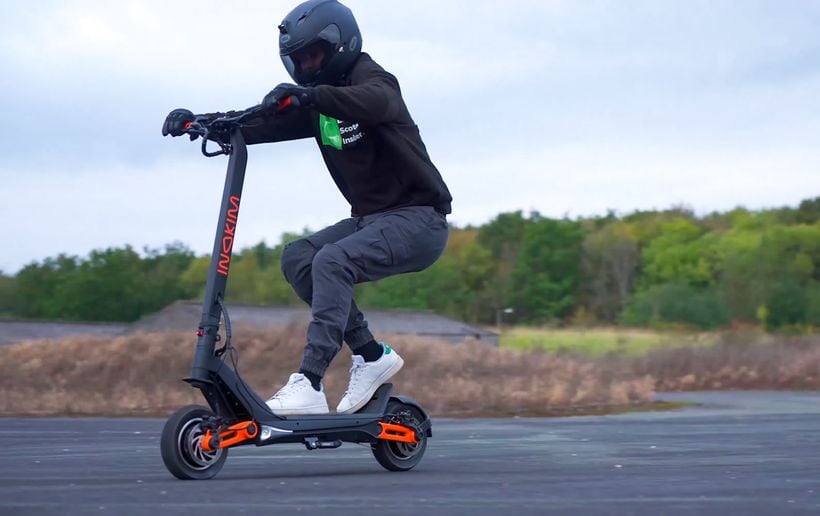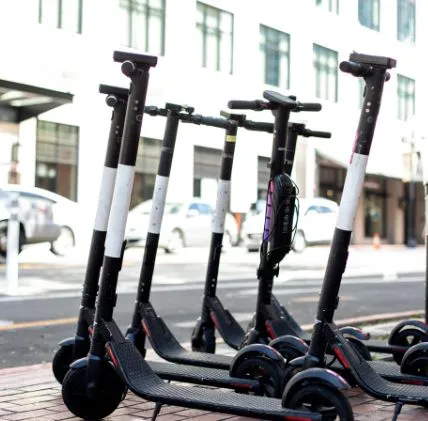Yes, you can ride an electric scooter manually by using its footboard as a standard standing scooter. Electric scooters can be ridden manually by pushing off with your foot and using your own body weight and balance to propel forward.
This allows for a flexible and versatile riding experience that can accommodate various situations and preferences. Whether you want to conserve battery power, exercise, or simply enjoy a traditional scooter ride, riding an electric scooter manually is a viable option.
Contents
Understanding The Basics
Electric scooters can be ridden manually, allowing you to control your speed and direction without relying solely on the motor. This flexibility gives riders the option to conserve battery life and enjoy a more interactive experience.
Electric scooters have become increasingly popular as a convenient and eco-friendly mode of transportation. While most people are familiar with using electric scooters in their powered mode, there is often confusion about whether these scooters can be ridden manually. In this section, we will delve into the basics of electric scooters and shed some light on the possibility of riding them manually.
How Do Electric Scooters Work?
Electric scooters work by utilizing a battery-powered motor to provide propulsion. Here’s a brief overview of how they operate:
- Battery Power: Electric scooters are equipped with rechargeable batteries that supply the necessary power for the motor.
- Throttle Control: The rider controls the speed by operating a throttle, similar to a motorcycle or bicycle.
- Motor and Drive System: The motor converts electrical energy from the battery into mechanical energy to propel the scooter forward.
- Brake System: Electric scooters have built-in braking mechanisms, such as disc brakes or regenerative braking systems, to ensure safe stopping.
What Does Manual Riding Mean?
Manual riding refers to the act of propelling a vehicle solely using physical effort, such as pushing off the ground with one’s foot. In the context of electric scooters, manual riding implies moving the scooter without engaging the electric motor.
Manual riding can be an option in situations like:
- Battery Drain: When the scooter’s battery is depleted or not charged, manual riding allows you to continue traveling using your own physical power.
- Fitness Benefits: Opting for manual riding can provide an additional workout, as you engage your muscles to propel the scooter forward.
- Regulation Compliance: In some areas, riding an electric scooter only in its manual mode may be required due to local regulations or restrictions.
The Difference Between Electric And Manual Scooters
While electric scooters and manual scooters may seem similar, there are key differences between the two:
Electric Scooters:
- Powered by a battery and motor
- Controlled through a throttle or acceleration mechanism
- Suitable for longer distances and effortless travel
- Often equipped with additional features like lights, horns, and suspension systems
- Require charging and maintenance of the electrical components
Manual Scooters:
- Relies on physical exertion to propel forward
- Controlled by pushing off the ground with one’s foot
- Ideal for shorter distances and maneuverability in crowded areas
- Simpler in design and typically more lightweight
- Low maintenance requirements, as there are no electrical components to consider
Understanding the basics of electric scooters and the differences between manual and electric modes can help you make an informed decision based on your specific needs. Whether you prefer the convenience of electric power or the simplicity of manual riding, electric scooters offer a versatile transportation option.

Limitations Of Manual Riding
Electric scooters offer the convenience of manual riding, but their limitations can be a drawback. Operating an electric scooter manually may be tiring and inefficient for longer distances, making it less viable as a primary transportation option.
Safety Concerns While Riding Manually
- Manual riding an electric scooter can pose certain safety risks, especially if proper precautions are not taken.
- Riding a scooter manually removes the automatic stability and balance provided by the electric motor.
- Here are some safety concerns to consider when riding an electric scooter manually:
- Balance and stability: Riding a scooter manually requires a strong sense of balance and stability, as the scooter’s self-balancing features are disabled. This can make it more challenging to navigate uneven terrain or congested areas.
- Braking distance: Manual riding may increase the braking distance compared to riding with the electric motor engaged. It’s essential to compensate for this and react promptly to avoid any accidents.
- Speed control: Riders must rely solely on their physical strength to control the speed of the scooter. This may require more effort and control, especially when going downhill or during sudden stops.
- Maneuverability: Manual riding may impact the scooter’s overall maneuverability, making it more difficult to make sharp turns or navigate tight spaces.
Remember, it’s crucial to wear protective gear, such as a helmet and knee pads, when riding an electric scooter manually. Additionally, taking some time to practice in a safe and controlled environment can help improve your skills and reduce the risk of accidents.
Factors To Consider When Deciding To Ride Manually
- Before opting for manual riding, there are several factors to take into account. Consider the following:
- Physical fitness: Riding an electric scooter manually requires more physical effort compared to riding with the electric motor. Ensure you have the strength and endurance to handle the additional exertion.
- Terrain: Consider the type of terrain you’ll be riding on. Manual riding may be more challenging on hilly or uneven surfaces compared to flat surfaces.
- Distance: If you plan to cover long distances, manual riding may not be practical due to fatigue. Evaluate if the scooter’s battery range meets your needs.
- Personal preference: Some riders enjoy the added control and physical engagement that manual riding provides. Consider your preferences and if you find manual riding more enjoyable and fulfilling.
As with any activity, it’s essential to evaluate your skills, physical capabilities, and personal preferences before deciding to ride an electric scooter manually. Remember that safety should always be a top priority.
Impact On Battery Life And Scooter Performance
- While riding an electric scooter manually can be an alternative option, it’s essential to understand its impact on the scooter’s battery life and overall performance.
Here are a few key points to consider:
- Battery consumption: Riding an electric scooter manually reduces the reliance on the battery since the electric motor is not being used. This means that the battery will last longer, allowing for extended riding sessions.
- Prolonged scooter life: Engaging the electric motor less frequently by riding manually can reduce the wear and tear on key components, potentially prolonging the scooter’s overall lifespan.
- Improved scooter efficiency: Manual riding allows for greater control over the scooter’s speed and acceleration, potentially leading to more efficient energy usage.
Keep in mind that riding manually requires physical exertion, which can influence how long you can ride before experiencing fatigue. Additionally, riders should regularly check the owner’s manual or consult with the manufacturer to ensure manual riding is supported by their specific electric scooter model.
Overall, manual riding can have positive effects on battery life and scooter performance. It provides riders with a more active and engaging experience while reducing reliance on the electric motor. Just make sure to monitor your energy levels and ride within your physical limits.
Techniques For Manual Riding
Electric scooters can be ridden manually with proper techniques. Learn how to ride without relying on the motor for a more interactive and engaging experience. Mastering manual riding allows you to have greater control and maneuverability over your scooter.
Riding an electric scooter manually can give you more control and a sense of freedom as compared to riding in automatic mode. By switching to manual mode, you can maneuver the scooter with precision and execute various techniques to enhance your riding experience.
Here are some techniques and tips for manual riding:
Using The Scooter In Manual Mode:
- Engage manual mode: To begin riding your electric scooter manually, you need to switch to manual mode. Refer to the user manual of your particular scooter model for the specific steps to activate manual mode.
- Utilize the throttle: In manual mode, the throttle control allows you to control the speed and acceleration of the scooter. Gradually apply the throttle to accelerate smoothly and maintain a comfortable speed.
- Practice braking: When riding manually, you’ll need to rely on the scooter’s brakes to slow down or come to a stop. Familiarize yourself with the brake mechanism and practice applying the brakes gradually to avoid sudden stops.
Tips For Balancing And Steering:
- Keep a balanced stance: Proper balance is essential for manual riding. Stand upright on the scooter with your feet shoulder-width apart. Distribute your weight evenly and maintain a relaxed posture to enhance stability.
- Align your body and scooter: Position your body in alignment with the scooter. Keep your shoulders parallel to the handlebars and face forward. This helps improve control and stability while steering.
- Use your body to steer: Manual riding involves using your body and shifting your weight to steer the scooter. Lean slightly in the direction you want to turn, and maintain a firm grip on the handlebars. Practice gradual and controlled movements to navigate corners and turns smoothly.
Recommended Speeds For Manual Riding:
- Familiarize yourself with speed settings: Electric scooters often have different speed settings depending on the model and manufacturer. Start with the lowest speed setting and gradually increase as you gain confidence and experience in manual riding.
- Suitable speeds for different scenarios: The recommended speed for manual riding may vary based on factors such as the road conditions and your comfort level. Generally, a moderate speed that allows you to maintain control and react to obstacles efficiently is recommended.
- Be mindful of your surroundings: Always ride at a speed that enables you to be aware of your surroundings and react promptly to any potential hazards. Adjust your speed based on the traffic, pedestrians, and road conditions to ensure a safe and enjoyable ride.
Remember, practicing manual riding techniques and gradually increasing your comfort level will help you become a skilled rider. Enjoy the freedom and control that electric scooters offer in manual mode, and always prioritize safety while riding.
Benefits And Drawbacks
Electric scooters offer the convenience of both manual and electric riding, allowing riders to switch seamlessly between the two. The benefits include eco-friendliness and cost-effectiveness, while drawbacks include limited speed and range in manual mode. Despite this, riding an electric scooter manually provides greater control and exercise for riders.
Benefits Of Manual Riding For Specific Situations:
- Greater control: Riding an electric scooter manually allows for more precise control over speed and maneuverability, making it ideal for navigating through crowded areas or tight spaces.
- Exercise: Manual riding gives you the opportunity to get some exercise while you commute or explore the city. Using your leg muscles to propel yourself forward can offer a low-impact workout.
- Extended battery life: By riding an electric scooter manually, you can conserve the scooter’s battery life and extend your riding time, especially when you’re not in a rush.
- Silent operation: When riding manually, electric scooters operate silently, allowing you to seamlessly blend into the surroundings without disturbing others.
Drawbacks And Challenges Of Manual Riding:
- Physical effort: Compared to riding in electric mode, manual riding requires physical effort, especially when climbing uphill or covering long distances. It may not be suitable for those with physical limitations or mobility issues.
- Limited speed: Riding an electric scooter manually may not provide the same level of speed as using the electric mode. This can be a drawback, particularly when you need to reach your destination quickly.
- Skill requirement: Manual riding demands a certain level of skill and balance, particularly for beginners. It may take some time to become comfortable and confident in riding manually.
Comparing Manual Riding To Electric Mode:
- Convenience: Electric mode offers the convenience of effortless riding, with minimal physical exertion. It allows you to cover longer distances without exerting much effort, making it convenient for commuting or traveling.
- Speed: Electric mode provides a speed advantage over manual riding, allowing you to reach your destination faster, especially on flat surfaces or downhill.
- Battery usage: Riding an electric scooter in electric mode consumes battery power faster. This may require more frequent recharging, limiting your overall riding time compared to manual riding.
- Cost-effectiveness: Manual riding eliminates the need for recharging or replacing batteries, making it a more cost-effective option in the long run.
Manual riding offers benefits such as greater control, exercise, extended battery life, and silent operation. However, it also comes with challenges like physical effort, limited speed, and skill requirements. Comparing it to electric mode reveals differences in convenience, speed, battery usage, and cost-effectiveness.
Ultimately, the choice between manual and electric riding depends on individual preferences, specific situations, and personal needs.
Frequently Asked Questions
Can You Manually Ride An Electric Scooter?
Yes, you can ride an electric scooter manually just like a regular non-electric scooter.
How Do You Ride An Electric Scooter Manually?
To ride an electric scooter manually, simply push off with your foot and use your body weight to steer and balance the scooter.
Is It Difficult To Ride An Electric Scooter Manually?
Riding an electric scooter manually is not difficult. It requires basic balancing skills and is similar to riding a regular scooter.
Can You Switch Between Manual And Electric Mode While Riding?
Yes, most electric scooters allow you to switch between manual and electric modes while riding for added flexibility and convenience.
What Is The Benefit Of Manually Riding An Electric Scooter?
Manually riding an electric scooter helps conserve battery life and gives you the option to continue riding even when the battery is depleted.
Final Thoughts
Riding an electric scooter manually can definitely be a fun and convenient option for many riders. Not only does it provide a sense of control and freedom, but it also allows riders to conserve battery life and enjoy a more active experience.
With the ability to kick start the scooter and use it like a traditional non-electric scooter, riders can navigate through tight spaces and maneuver around obstacles with ease. Additionally, manual riding can be particularly useful when the battery runs out or when riders prefer a more traditional mode of transportation.
However, it is important to keep in mind the limitations of manual riding, as it can be physically demanding and may not be suitable for long distances or uphill terrains. Overall, mastering the skill of manual riding can be a valuable asset for electric scooter owners, providing them with flexibility and a more versatile riding experience.
So, go ahead and give it a try – you may discover a whole new way to enjoy your electric scooter.


